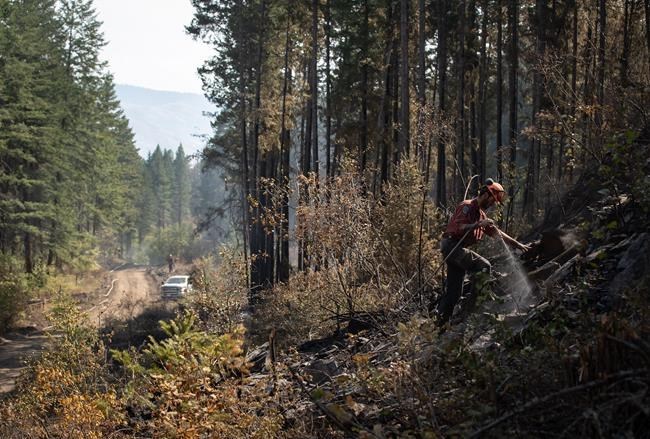
Wildland firefighter Ty Feldinger works on steep terrain to put out hot spots remaining from a controlled burn on Okanagan Indian Band land, northwest of Vernon, B.C., Wednesday, Aug. 25, 2021.The director of provincial operations for British Columbia's wildfire service says B.C. needs a "holistic," large-scale program to reduce fire risk, starting from backyards, then to surrounding communities and extending to forested lands. THE CANADIAN PRESS/Darryl Dyck
March 18, 2022 - 2:29 PM
KAMLOOPS, B.C. - The director of provincial operations for British Columbia's wildfire service says the province needs a "holistic," large-scale program to reduce wildfire risk, starting in backyards, moving to communities then extending to forested lands.
Cliff Chapman says planning is underway to decide how new funding will be used to increase the service's capacity, while it partners with the forest industry, B.C. Cattlemen's Association, First Nations, communities and other stakeholders.
B.C.'s budget released last month allocated $145 million over three years for Emergency Management BC and the BC Wildfire Service to kick-start the province's transition to a more "proactive approach" to wildfire preparedness and response.
The funding will be used to help the wildfire service increase its permanent, year-round staffing, allowing it to focus on every aspect of emergency management for wildfires, including prevention and mitigation, preparedness, response and recovery.
The government allocated another $98 million for prevention work and maintenance on forestry roads, while $26 million is earmarked to upgrade the wildfire service's facilities.
Chapman told a news conference the service is currently assessing how many seasonal staff are interested in becoming permanent and he expects there will be good uptake as crews are proud of the work they do to protect communities.
The service already employs about 400 full-time staff, while about 1,000 staff join each year for "what has become more of an eight-month season," he said.
They're looking to achieve a "fairly sizable increase" in full-time staffing by September, following an increase of 50 to 100 staff for this season, he said.
Some seasonal staff already returned last November to help respond to widespread flooding that swamped communities and severed highways, Chapman noted.
Ravi Kahlon, minister of jobs and economic recovery, told the news conference on Friday that the new funding should "go a long way" to ensure communities are safe.
After two years of below-average fire activity, the 2021 season saw more than 1,600 fires scorch close to 8,700 square kilometres of land between April and September.
A provincial state of emergency declared on July 21 lasted 56 days, ending in mid-September, and the fires triggered more than 180 evacuation orders.
Much of the village of Lytton was destroyed by wildfire just one day after the temperature in the community southwest of Kamloops hit an all-time Canadian high of 49.6 C.
Fires also destroyed dozens of homes and buildings between Kamloops and Vernon and near Kelowna.
This report by The Canadian Press was first published March 18, 2022.
News from © The Canadian Press, 2022